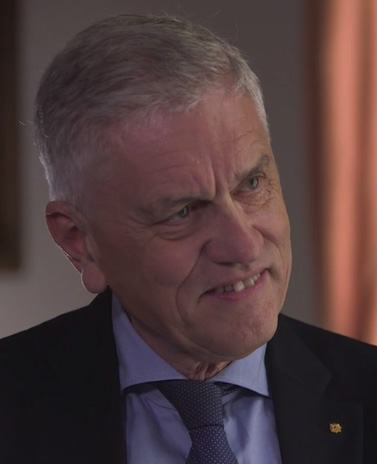Translation of cell therapies for neurodegenerative diseases
Cell Gene Therapy Insights 2016; 2(3), 387-390.
10.18609/cgti.2016.042
You pioneered cell replacement strategies for the treatment of neurological conditions; how does cell therapy represent a better option for treating neurodegenerative disesases such as Parkinsons?
Compared to drug treatments, where the drug reaches all parts of the brain, what we are aiming is to repair just the area of the brain where neurons have died, so it’s a more focal and goal-directed repair of what has been lost. This means that you would not see the adverse effects that you would get from the drug reaching not only the areas where it’s needed but also other areas of the brain or body. That is what we hope for, but this line of research and clinical endeavour is also driven by the desire to actually reconstruct the brain. What we aim to achieve is reconstruction of the neural circuitry and have healthy neurons replacing those which have died. Our aim is to replace the dopamine-producing neurons which secrete dopamine and form synaptic contacts. That is a different approach to just seeking to transplant cells in the form of a biological mini-pump, because we know from prior studies that have been performed over the last three decades that the biological mini-pump is just not sufficient. If you are going to replace the dopamine cells to generate a substantial clinical benefit, the cells have to be of the neural phenotype that are lost, the substantia nigra. But if they are just dopamine-secreting cells, you can have some effect but not the optimal outcome.
Why do you think a number of cell therapy clinical trials for Parkinson’s have failed in the last decade?
The open label trials which were performed in the 1980s and early 1990s were done so without any sham surgery controls. But they were pioneering – at that stage we didn’t know even if the cells would survive and the main objective was not to provide an effective treatment for Parkinson’s disease it was to see whether neurons can survive transplantation into the adult human brain. The step change to human clinical trials was huge – we’re not talking about rodents, we’re talking about 50–60 year-old patients with chronic disease and long-term medical treatment histories; therefore our initial objective was to check whether the cells could simply survive and to provide proof of concept that it can work as an approach.
Meanwhile, two American studies were initiated in the 1990s and were published in 2001 and 2003, and were performed with sham surgery controls. Although subgroup analysis showed some positive effects in one of the studies, the primary outcome was negative. One plausible explanation for this negative outcome is that the number of surviving dopaminergic cells in the patient’s brain, as evidenced by post mortem autopsy, was very low and that could certainly influence the outcome. The second study actually observed a positive effect in the first 6 months post transplantation, but upon withdrawing immune suppression there was a rapid deterioration in the patients, resulting in no discernible difference between the sham group and the transplanted group. Furthermore, the patients in this trial were at a very advanced stage of disease and so regeneration of the dopamine system could be less efficient as compared to when transplantation is performed earlier in the disease. We now understand a lot more about why these early trials it didn’t work as expected, but the damage was done and further progress in clinical trials has been halted for more than a decade now.
Your work has also focused on improving recovery following stroke. Can you tell us a little bit more about this approach and how far advanced the work is?
In principle, there are two mechanisms of action when you talk about stem cells and transplantation for stroke. One is to replace lost neurons which have died due to the stroke and thus reconstruct a circuitry – and that’s a cell replacement strategy; however, it’s also become obvious that when you add stem cells, progenitor cells or mesenchymal stem cells for example into the brain following stroke you see a clinical improvement that has nothing to do with the replaced neurons. What we’re actually seeing are mechanisms of immune modulation, trophic effects and effects on plasticity that are causing this improvement. In clinical trials that are ongoing with mesenchymal stem cells and monocytes, and also one study with neural stem cells, it is mainly this effect, this bystander effect, which is being studied and from this we will start to have a much better understanding of how to optimize this effect to support clinical improvement. The second approach is actual cell replacement and we are working on this particular mechanism using animal models. After a stroke, there are many cells that die – neurons of all different types. The question is can you replace those different kinds of neurons that have died due to stroke, and construct the circuitry to see a clinical benefit? We now know that it is possible to make neurons from skin cells and transplant these neurons into the cerebral cortex and that neuron can function as a neuron, and forms connections in the animal’s brain. What we don’t know exactly is how much of the observed improvement following stem cell transplantation in the stroke model is dependent on this circuit reconstruction process and also how to optimize the reconstruction. Over the coming years we will see how much improvement can be achieved via this trophic bystander effect and then in parallel see how far can we move forward with the cell replacement strategy for stroke.
What challenges remain before cell therapies can become a standard of care within degenerative diseases?
I think that it will take time. It has been 30 years since I started working on cell therapy trials in patients and I often get questions from journalists as to why a competitive treatment for Parkinson’s disease has not yet been developed. But one should be aware that when I started working in clinical neurology in 1976, everybody believed that this cell therapy approach would never work, that it is not possible to repair anything in the human brain. My boss and my first professor in clinical neurology said that clinical application of brain repair in patients has never been possible in the past and will never be possible in future. I don’t think it has taken such a long time to progress to the stage we are now at and we have learnt so much along the way; but I think it will take time before we have clinically competitive therapies. In the coming 3 to 4 years we will see the first scientifically-based stem cell transplantation trials for example in Parkinson’s disease. But how much more time and research will be required to establish these cell therapies as the standard treatment for neurological patients is very difficult to predict.
Affiliation
Olle Lindvall
Professor of Clinical Neurology and Chairman of the Division of Neurology at the University Hospital, Lund, Sweden

This work is licensed under a Creative Commons Attribution- NonCommercial – NoDerivatives 4.0 International License.

